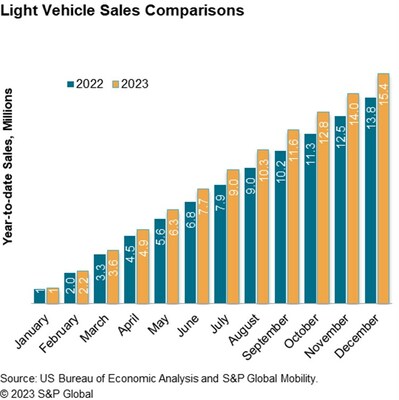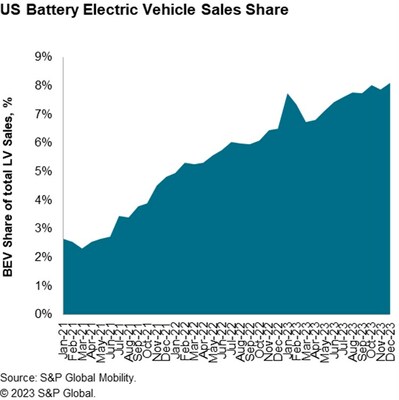S&P Global Mobility: December auto sales wrap up year on a familiar note
- Projected increase of 2.0% in US auto sales volumes for 2024
- Global forecast of 88.3 million sales in 2024
- Deceleration of average pace of sales in the fourth quarter of 2023
- Heightened risk for auto demand due to consumer affordability issues
Insights
The recent update on the U.S. auto sales pace, indicating a projected annual rate of 15.2 million units, reflects a subtle decline from the second quarter's 15.8 million units. This trend suggests a potential cooling in the automotive market, which may have various implications for investors and stakeholders. It's imperative to consider the economic indicators such as consumer spending power, interest rates and credit conditions, which are alluded to as factors affecting vehicle affordability and, consequently, demand.
While the forecasted increase in sales for 2024 is modest at 2.0%, it is essential to scrutinize the underlying market dynamics. The mention of inventory levels and incentives progressing positively could indicate a strategic shift by automakers to balance production and demand, potentially stabilizing prices. However, the concern that consumers might be 'tapped out' raises questions about the sustainability of demand, especially in the face of persistent high interest rates and tight credit conditions.
In the short-term, stakeholders might experience a volatile market, with sales potentially influenced by external economic factors. Long-term implications could include industry shifts towards more aggressive pricing strategies or a reevaluation of production targets to align with consumer demand. Investors should monitor these developments closely, as they could significantly impact automotive companies' profitability and stock performance.
The automotive industry serves as a barometer for broader economic health, with auto sales often correlating with consumer confidence and disposable income levels. The deceleration in the sales pace from Q2 to Q4 of 2023 and the cautious projection for 2024, may hint at broader economic headwinds. High interest rates and stringent credit conditions are likely reflecting tighter monetary policy aimed at controlling inflation, which in turn affects consumer spending.
The affordability issues mentioned are particularly concerning as they suggest that even with improved inventory and incentives, the fundamental issue of purchasing power remains. This could lead to a shift in consumer behavior, potentially increasing demand for used vehicles or alternative transportation methods, which could disrupt traditional auto sales models.
Understanding these economic trends is crucial for businesses and investors, as they could lead to changes in consumer spending patterns that extend beyond the auto industry. Companies may need to innovate in terms of financing options or vehicle offerings to adapt to these shifts. For investors, these trends could inform decisions about the attractiveness of the automotive sector relative to other industries that might be better positioned to weather an economic downturn.
From an industry perspective, the projected sales pace suggests a potential stabilization in the auto market after a period of recovery and growth. The increase in advertised new vehicle dealer inventory listings could be a sign that supply chain issues are being resolved, which has been a significant challenge for the industry in recent years. However, the increase in inventory also raises the question of whether this reflects an alignment with demand or an overestimation of market appetite.
The dual nature of the news, with both positive and negative signals, indicates that automakers and dealerships may need to be more agile in their strategies. The emphasis on incentives and dealmaking could become more pronounced as companies strive to attract consumers who are facing financial constraints. This could lead to a more competitive market, with price wars and promotional tactics becoming more common.
For the industry, the ability to quickly adapt to changing consumer preferences and economic conditions will be crucial. For example, a pivot towards electric vehicles or more affordable models could be necessary to maintain sales momentum. The industry's response to these challenges will be critical for investors to watch, as it will likely have a significant impact on market share and profitability.
Little movement in pace of sales sets stage for an uncertain 2024 landscape
S&P Global Mobility projects US sales volumes are expected to reach 15.9 million units in 2024, an estimated increase of
"The end of 2023 brings the industry a glimpse into what could be yet another uncertain environment for US auto sales levels in 2024," said Chris Hopson, manager of North American light vehicle sales forecasting for S&P Global Mobility.
"The good news is that incentives and inventory levels are progressing in the right direction. The not-so-good news is that this has not yet translated to momentum for sales levels," Hopson said. "This could be a stouter signal that US consumers are tapped out, which would be a heightened risk for auto demand as new vehicle consumers continue to face affordability issues by way of high interest rates, tight credit conditions and slow-to-recede vehicle prices."
"An uneasy consumer translates to an expectation of a mildly progressing auto sales environment next year," Hopson added." Stronger advances in new vehicle inventory could potentially result in increased incentives and dealmaking to help mitigate consumer headwinds."
Dealer advertised vehicle inventories continue to climb. Advertised new vehicle dealer inventory listings for the US market have increased to about 2.3 million units as of early December, said Matt Trommer, associate director of Market Reporting at S&P Global Mobility. This represents an increase of
"The November surge was mostly driven by the Compact SUV segment, with the Toyota RAV4, Chevrolet Equinox, Mazda CX-5, and Nissan Rogue having shown large increases in inventory every month since August," Trommer said.
Dec 23 (Est) | Nov 23 | Dec 22 | ||
Total Light Vehicle | Units, NSA | 1,372,400 | 1,218,647 | 1,268,897 |
In millions, SAAR | 15.2 | 15.3 | 13.5 | |
Light Truck | In millions, SAAR | 12.2 | 12.3 | 10.7 |
Passenger Car | In millions, SAAR | 3.0 | 3.0 | 2.8 |
Source: S&P Global Mobility (Est), US Bureau of Economic Analysis | ||||
Continued development of battery-electric vehicle (BEV) sales remains an assumption in the longer term S&P Global Mobility light vehicle sales forecast. In the immediate term, some month-to-month volatility is anticipated. December 2023 BEV share is expected to reach
With the rollout of several highly anticipated models, US BEV sales will continue to develop in the new year. By the end of 2024, there will be nearly 100 BEV models available, double the number there were in 2022, covering several more segments and providing consumers interested in an electric vehicle even more choice. As for vehicles already on sale, advertised dealer inventories of most non-Tesla EVs have plateaued.
About S&P Global Mobility
At S&P Global Mobility, we provide invaluable insights derived from unmatched automotive data, enabling our customers to anticipate change and make decisions with conviction. Our expertise helps them to optimize their businesses, reach the right consumers, and shape the future of mobility. We open the door to automotive innovation, revealing the buying patterns of today and helping customers plan for the emerging technologies of tomorrow.
S&P Global Mobility is a division of S&P Global (NYSE: SPGI). S&P Global is the world's foremost provider of credit ratings, benchmarks, analytics and workflow solutions in the global capital, commodity and automotive markets. With every one of our offerings, we help many of the world's leading organizations navigate the economic landscape so they can plan for tomorrow, today. For more information, visit www.spglobal.com/mobility.
Media Contact:
Michelle Culver
S&P Global Mobility
248.728.7496 or 248.342.6211
Michelle.culver@spglobal.com
![]() View original content to download multimedia:https://www.prnewswire.com/news-releases/sp-global-mobility-december-auto-sales-wrap-up-year-on-a-familiar-note-302021832.html
View original content to download multimedia:https://www.prnewswire.com/news-releases/sp-global-mobility-december-auto-sales-wrap-up-year-on-a-familiar-note-302021832.html
SOURCE S&P Global Mobility
FAQ
What is S&P Global Mobility's projection for US auto sales volumes in 2024?
What is the global forecast for auto sales in 2024 by S&P Global Mobility?










